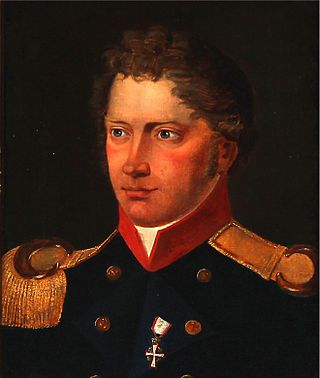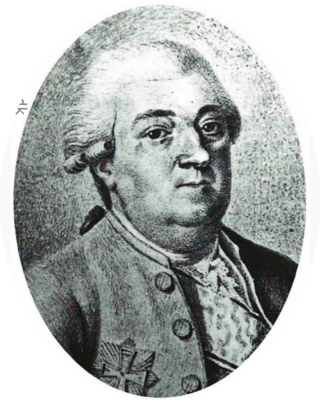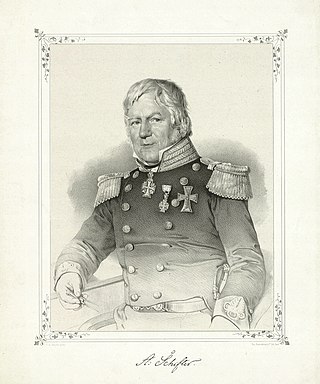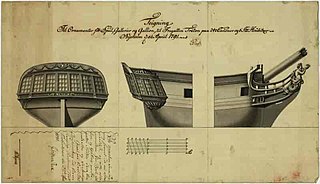Related Research Articles

Jens Schou Fabricius was the Norwegian appointed Minister of the Navy 1817–1818. He served as a representative for Søe-Deffensionen at the Norwegian Constitutional Assembly at Eidsvoll in 1814. During his naval career he served first the Danish Crown until the separation in 1814 of Norway from Denmark, and thereafter the Norwegian-Swedish Crown. Fabricius retired from the navy as a vice admiral.

The Sophia Amalia was a ship of the Royal Dano-Norwegian Navy named after Sophia Amalia, the wife of King Frederick III.
HDMS Søormen was a 12-gun cutter of the Royal Dano-Norwegian Navy, built in 1789. After being captured by the British in 1808 she was added to the Royal Navy as HMS Salorman. She was wrecked in 1809.

Peter Nicolay Skibsted (1787–1832) was a Danish naval officer with a successful career marred only by the loss in 1810 of a squadron of three gunboats under his command to the British.
The name of Steen Andersen Bille is closely associated with one extended family of Danish naval officers over several generations.
HDMS Friderichsværn was a Danish frigate built at Nyeholm, Copenhagen, in 1783. The British Royal Navy captured her in 1807 and took her into service as HMS Frederickscoarn. It sold her in 1814.
Henrik Lorentz Fisker was a successful naval officer in the service of Denmark. He was the son of an attorney at the supreme court, and deputy mayor of Copenhagen. From the age of thirteen as a cadet in the Danish-Norwegian navy, he rose through the ranks to vice admiral in 1775 and full admiral in 1790. He died 20 June 1797 and was buried in the Holmens Kirkegård, the Danish naval cemetery, in Copenhagen.

Henrik Gerner (1742–1787) was a Danish naval officer who specialised in shipbuilding and naval architecture. His interests as an entrepreneurial engineer led to unsinkable gun platforms, horse-driven dredging machines, and desalination equipment for Orient-bound trading ships.

Ernst Wilhelm Stibolt was a Danish naval officer and ship builder, who served in the French navy for four years. and became a member of the Royal Danish Academy of Sciences and Letters.

Frantz Christopher Henrik Hohlenberg was a Danish naval officer who specialised in ship design and had little seagoing experience. He succeeded Ernst Wilhelm Stibolt as Master Shipbuilder (fabriksmester) at the Royal Danish Dockyards in 1796. His ships included five ships of the line and 18 frigates. Three of the ships of the line and nine of the frigates were captured at the 1807 Battle of Copenhagen and subsequently added to the Royal Navy. He resigned after a controversy in 1803.

Frederik Michael Krabbe (1725–1796) was a Danish naval officer and master shipbuilder (fabrikmester)

Diderich de Thurah (1704–1788) was a military cadet, a naval officer in the Royal Danish-Norwegian navy, shipbuilder and fabrikmester, artist and publisher.
Knud Nielsen Benstrup was a Danish naval officer and the senior officer, overfabrikmester, at the Royal Danish naval shipyards, until his career was blighted by court martial and imprisonment.
HDMS Christianus Sixtus (1733) was a three-deck 90-gun ship-of-the-line designed to be the flagship of the Danish fleet, and named after the monarch of the time, King Christian VI

Andreas Schifter (1779–1852) was a Danish naval officer and shipbuilder, a capable naval administrator and admiral. He oversaw the transition of the Danish navy from sail to early steam power.
Rasmus Krag (1680–1755) was a Danish naval officer who first became a junior lieutenant in 1700 and vice-admiral in 1736. He aspired to be a naval architect but his efforts proved unsatisfactory.

Michael Bille (1680–1756) was an officer in the Danish Royal Navy during the Great Northern War. He was commissioned as a junior lieutenant in 1699, advancing steadily to become Vice admiral when he retired in 1737.

HDMS Triton was a Danish frigate launched in 1790 which operated in Danish/Norwegian home waters and in the Mediterranean in the protection of Danish merchant ships - not only from Barbary pirates but also from potential British privateers. The period in which it operated was fraught with political and practical difficulties which led to two battles at Copenhagen and other, lesser, actions.

HDMS Justitia was a Royal Dano-Norwegian Navy ship-of-the-line, built to a design by Henrik Gerner. Although launched in 1777, she was not fully commissioned until 1780. The British Royal Navy seized her in 1807, together with the rest of the Danish fleet after the second battle of Copenhagen. The British never commissioned Justitia. A renaming to Orford in 1809 was cancelled. She was broken up in 1817.

HDMS Justitia was a ship-of-the-line designed by Ole Judichaer built at Nyholm, Copenhagen for the Royal Danish-Norwegian Navy.
References
- Gyldendal - Th. Topsøe-Jensen: Knud Benstrup in Danish Biographical Leksikon, 3. edition, Gyldendal 1979-84. accessed 27 August 2019
- Royal Danish Naval Museum for all warships attributed to a named shipbuilder. From the website follow Database > Avancerede > Set Konstructør to (name wanted) > Søg (This works only if the language is set to Danish) For particular types of ships, follow the same path, but set the filter accordingly.
- Royal Danish Naval Museum - List of Danish Warships
- Royal Danish Naval Museum - Skibregister
- Salmonsens konversationsleksikon / Anden Udgave / Bind XIII: Jernbaneret—Kirkeskat /
- (in Danish)T. A. Topsøe-Jensen og Emil Marquard (1935) “Officerer i den dansk-norske Søetat 1660-1814 og den danske Søetat 1814-1932“. Two volumes. Download here Archived 2020-02-13 at the Wayback Machine .